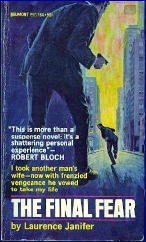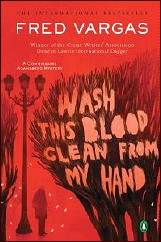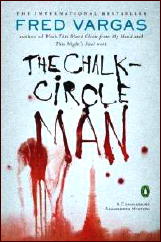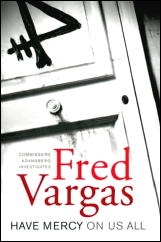REVIEWED BY DAN STUMPF:
LAURENCE JANIFER – The Final Fear. Belmont B50-764, paperback original, 1967.
I read Laurence Janifer’s The Final Fear back in high school, and for some reason it stayed on my shelf all this time, so the other day I decided to take it out and have a re-read after 40+ years. Robert Bloch had some kind words to say about it, so I figured it might be worth another look.

Well, it’s interesting. Not entirely successful, and I don’t know if I’d recommend it very highly, but it has its moments. The whole thing has kind of a rushed feel to it, starting out with the plot, if you want to cal it that, already underway: the Hero running for his life as the Villain shoots at him on a New York street, with the Heroine and Good Friend yet to make an appearance.
This is basically a four-character drama, as if Janifer (a busy sci-fi hack in those days) wanted to rush through it without too much bother. It quickly develops that the Hero is Jack Roe, a high school English teacher who had an affair with the Heroine, Madeline, whose husband Edward learned he had only six months to live and decided to kill the man who wrecked his happy home.
The Good Friend, a police detective, comes in just a bit later, primarily to move the plot along. And that’s pretty much it. Edward shows up and shoots at Jack, who runs away and talks to Madeline for a bit, then Edward shows up, shoots at Jack, who runs away and talks to the cop for a bit, then Edward shows up.
Somewhere along the way, this acquires an almost poetic simplicity, like a ballad oft-repeated, or a Woolrich tale set in some hostile universe where the price of love is death.
But it never gets to the level of good writing in any conventional sense. Janifer moves his tale across New York City in the late 60s, when the rotting arcades and crumbling theaters held a sleazy splendor all their own, none of which he evokes here. Instead, he simply runs from one scene to the next: Washington Square, Greenwich Village, the subway, Central Park…
We go through all this and more, but never with the sense of having been there. His police detective, on the other hand, is pure Woolrich: a patient, thoughtful man with nothing but time on his hands and apparently working a 24-hour shift because he can turn up any time the plot calls for him.
The Final Fear didn’t give me time to get bored, but somehow it never really grabbed me either.
Editorial Comment: It’s possible that it’s large enough for you to read it from the cover image provided, but in case it’s not, here’s the blurb from Robert Bloch which I’m sure Belmont has happy to use: “This is more than a suspense novel; it’s a shattering personal experience.”
IT IS PURELY MY OPINION
Reviews by L. J. Roberts
FRED VARGAS – Wash This Blood Clean from My Hand. Knopf-Canada, hardcover, 2007. Penguin, US, trade paperback, 2007. First published as Sous les vents de Neptune, Paris : Viviane Hamy, 2004; translated by Sian Reynolds.
Genre: Police procedural. Leading character: Commisioner Adamsberg; 5th in series (4th translated into English). Setting: Canada.

First Sentence: Leaning his shoulder against the dark basement wall, Jean-Baptiste Adamsberg stood contemplating the enormous central heating boiler which had suddenly stopped working, two days before.
Comm. Jean-Baptiste Adamsberg and seven of his officers are getting ready for forensics training in Quebec, Canada. A few days before they are to leave, Adamsberg sees a news story about a murder where the victim received three stab wounds to the stomach and the accused has no memory of committing the crime.
A number of similar crimes, including one where Adamberg’s brother was accused, occurred 16 years ago. Adamsberg is certain the true killer is back, except that he attended the man’s funeral. Now in Canada, another murder occurs, but this time it appears Adamsberg is the killer.
The most important elements of a book, for me, are the characters. Vargas creates wonderful characters, although she does not provide as much background with each book as a reader coming into the middle of the series should have.
However, once you do start to know the players, they become real and characters about whom you want to know more. What is appealing about Adamsberg is that is he a very unconventional policeman, yet he gets results and has the loyalty of his colleagues and friends.
Vargas’s voice is wonderfully effective. Originally written in French, I appreciate that the translation still has a Gallic undertone to the text. Her descriptions are vivid and her phrasing lush. She has an excellent ear for dialogue, and a delightful sense of humor.
The plot of Wash This Blood is so well done. Yes, there are coincidences — it is rare to find a book without them — but it is also very clever with excellent twists and a soupçon of poignancy that adds dimension to Adamsberg’s character.
It is also the first time I recall that we see Adamsberg really lose his temper, which humanizes him even more. I’ve one criticism in that it feels as though there is a book missing from the series. Knowing how Have Mercy ended, this did cause a bit of confusion in terms of series plot continuity.
This was an excellent read. I highly recommend both it and the series which must be read in order — frustrating as the English versions have not been published in series order.
Rating: Excellent.
The Chief Inspector Adamsberg series —
1. The Chalk Circle Man (2009). First published in France as L’Homme aux cercles bleus (1991).
2. Seeking Whom He May Devour (2004). First published in France as L’Homme à l’envers (1999).
[*] The Four Rivers. Date? [Graphic novel]. Published in France as Les quatre fleuves (2000).
3. Have Mercy on Us All (2003). First published in France as Pars vite et reviens tard (2001).
[*] Coule la Seine (2002). [Collection of graphic stories.] Not yet published in English.
4. Wash This Blood Clean from My Hand (2007). First published in France as Sous les vents de Neptune (2004).
5. This Night’s Foul Work (2008). First published in France as Dans les bois éternels (2006).
6. An Uncertain Place (2011). First published in France as Un lieu incertain (2008).
Editorial Comment: Please consider this bibliography a work in progress. Dates for the French editions are based on information obtained from Wikipedia-France. Dates for the English editions are (I think) a mixture of US and Canadian first printings.
In any case, L.J. is correct in suggesting that readers of the series in the US have been treated badly by Ms. Vargas’s publishers. One can assume, however, that perhaps they started with what they believed to be a stronger title in the series, uncertain of the reception her books might receive.
Whether one must read the graphic novel or collection listed above (without number) in order not to miss any of the overall series continuity is at present unknown, but it would explain L.J.’s comment regarding “a book [she felt was] missing from the series.”
COLLECTING PULPS: A MEMOIR
PART FOUR — DETECTIVE STORY MAGAZINE
by Walker Martin

We have so far discussed and covered the so called Big Three: Black Mask, Dime Detective, and Detective Fiction Weekly. However there was a fourth magazine that has not received the proper attention that is due especially when you consider influence and the number of issues published. Detective Story Magazine with the October 5, 1915 issue became the very first pulp magazine to be devoted entirely to detective, mystery and crime fiction.
In fact it just about started the trend for pulps to be devoted to one genre. Earlier examples are Railroad Man’s Magazine in October 1906 and The Ocean in March 1907. But with Detective Story the publisher, Street & Smith, got the idea to develop a line of magazines such as Western Story, Sport Story, Sea Stories, Outdoor Stories, and Love Story. The title showed the reader exactly what type of story he could expect to read.
Not only was this the first of many detective and crime magazines, but it lasted longer than any other detective pulp magazine, 1057 issues during 1915 through 1949. The 1057 issues are even more than 929 issues of Detective Fiction Weekly.

Not too many collectors bother with Detective Story and it certainly is not on the same level as Black Mask, Dime Detective, and Detective Fiction Weekly, but it did publish a lot of interesting stories. In fact if you read and collect hero pulp fiction then Detective Story should be of interest to you because the magazine dealt with heroes and villains, some of which wore costumes and fought crime figures before the first hero pulp titles started in the early 1930’s.
The early issues still showed the dime novel origins (Nick Carter), but soon the fiction moved away from the teenage boy market and started to appeal to the adult mystery and detective fan. Even in 1916 it was possible to read such writers as Johnston McCulley, Sax Rohmer, Caroline Wells and H. Bedford-Jones.
With the February 20, 1917 issue the crude covers improved, showing more color, the price was increased to 15 cents, and 30 extra pages were added for a total of 160. Frank Blackwell was editor, though Nick Carter was first credited, and he remained editor for at least 20 years. Since he also would edit Western Story starting in 1919, he must of had a staff of assistant editors to help with these weekly magazines.

Another man who also lasted 20 years was the cover artist, John A. Coughlin. I know it is hard to believe but he did every cover each week for around 20 years, 1915-1935. As I was recently looking through my set I was watching for some other artist but I never noticed anyone else but Coughlin.
That’s 52 cover paintings each year or over 1,000 for the 20 years. Plus he was doing covers off and on for just about all the other Street & Smith pulps.
During the years I’ve owned several of his cover paintings from Detective Story and at present I still have two. It’s very interesting to see the development of Coughlin as an artist, from the crude early paintings in 1915 and 1916 to his excellent symbolic later work.
I don’t know of any other pulp cover artist who dominated one magazine so thoroughly for a thousand issues. I guess the closest would be Nick Eggenhofer but his work was mainly interior drawings in Western Story and other pulps.
From just about the very beginning the magazine specialized in series characters and in fact there were so many series that I sometimes mistakenly refer to the pulp as Detective Series Magazine. There are perhaps close to a hundred different series, too many to list in this article but I’d like to point out a few of the more interesting ones.

Johnston McCulley was the leader by far and was an expert at developing all types of series. In fact he is responsible for one of the most well known and recognized figures in literature and film, the series character Zorro.
The first series he developed for Detective Story was Black Star, followed by such characters as Terry Trimble, The Spider (no relation to the Norvell Page Spider), Thubway Tham, The Thunderbolt, The Man in Purple, The Avenging Twins, and the Crimson Clown. There may be others that I missed.
Probably the most outrageous character was the Crimson Clown who appeared in around 20 stories in the 1920’s. He’s a crime fighter but for some strange reason he dresses up as a clown in the full clown costume and makeup. I would think this would make him very noticable to the police and criminals.
The Spider appeared in about a dozen long novelettes in the teens and starred John Warwick as the gentleman crook who works for the criminal mastermind, The Spider. Thubway Tham appeared in over a hundred short stories mainly in the twenties and was a lisping pickpocket who worked the subways. The stories have a comedy element but I find them almost unreadable due to the lisping dialog whenever Thubway Tham opens his mouth. However the readers loved his adventures.

A favorite of mine stars John Flatchley, alias The Thunderbolt and his stupid sidekick, Saggs. It is the usual theme of the bored, rich young man robbing from the rich and giving to the poor, etc. He robs from six rich men who legally ripped off investors and he returns the money to the original owners. All this is done without bloodshed.
Erle Stanley Gardner’s Lester Leith was patterned after this type of character as were so many others. The hero wears a hood with a thunderbolt on it and is such a nice, good guy that he carries a gun, but it is empty with no bullets.
Street & Smith had a hardcover line called Chelsea House and many of the stories in these series were eventually published as books. All six stories about The Thunderbolt were collected into two Chelsea House hardcovers.
But there were plenty of other writers also dealing with series characters. Herman Landon, for instance, wrote about The Philanthropist who eventually developed into The Picaroon. Both heroes are gentlemen crooks but they are very strange indeed because after stealing money or jewels, they leave cards stating that the stolen items will be returned if the victim gives 10% of the value to charity.

The charity of choice is usually the Society of Prevention of Cruelty to Animals (SPCA). I find these novelettes absurd, but I love the insane character! Landon had another long running series starring a crime fighter and crook named The Gray Phantom.
One of the most fascinating series was by Arthur Hankins and starred an ex-cop and museum guard named Israel Pocket. The series appeared in 1918 and the hero works undercover in the stomach of a fake whale on exhibit. There he can spy on the museum visitors and prevent crime. His co-workers call him “Jonah.” Even as early as 1918 these six stories show that it was possible for quality fiction to exist in the pulps.
Another interesting series that ran for a long time in the 1920’s was by Roy Hinds and dealt with an elderly Jewish pawnbroker who aids criminals. The Simon Trapp series was humorous, and he was not your typical pulp hero. There is no redeeming Robin Hood morality in many of the stories, and often I finished a story thinking that Simon was crook and that was that.
The Doctor Bentiron stories written by Ernest Poate was another long-running series. Poate has been unjustly forgotten. Dr Bentiron is an interesting and strange character who lies around in his bathrobe, dribbling ashes and chain smoking. He is often bored but manages to solve crimes and has the habit of often grunting for some reason.
Amos Clackworthy by Christopher Booth was a major character whose adventures were reprinted in the Chelsea House hardcovers. Clackworthy is a sophisticated conman who with his sidekick, The Early Bird, gyps suckers and steals their money. Possibly this character had an influence on Erle Stanley Gardner’s Lester Leith character.

Ruth Aughiltree had one of the stranger characters called “Old Windmills”, who was a busy body, senile, old man who solved crimes. A strange detective who I found enjoyable and unintentionally funny.
Mother Hansen, like many of the series characters mentioned above, ran for many stories — another odd series. Written by Paul Ellsworth Triem, she was an old lady who by day sat behind a cash register in a seedy restaurant but in the night she helped reform criminals. The one I just read had a burglar breaking into her house but by the end of the story she has saved the crook from the police and helped him escape.
Edgar Wallace was one of the biggest stars of Detective Story in the twenties and in addition to the interesting “Ringer” series, he had over 20 serials. Only his early death silenced him.
There were many other series, too many to discuss in detail. One of the best of the early writers was Hugh Kahler, who has been just about completely forgotten today. For four years, 1918-1921, he wrote around 35 long novelettes all 40 to 50 pages in length. Just about all of them are well done, some starring series characters named The White Rook, The Joker, The Justice Syndicate.

The stories had elements in them that you usually do not see in pulp fiction from around 1918: love interest handled in an adult manner, well done characterization, a private detective acting in a believable way, and plots that are slowly and carefully developed, leading to a surprise ending.
There is not a lot of violence in these stories, and sometimes the crimes do not even involve murder. One of the more impressive villains is named “The Wiremaster,” who has killed 10 men by some means of electric shock. The ten were unconvicted murderers who had beat the system and the law.
The Wiremaster acts as a vigilante and like many of the heroes and villains likes to send weird letters and threats signed The Wiremaster, The Third Hand, The Picaroon, The Gray Phantom, or The Scarlet Scourge. One story even has a letter signed by “The Green Pansy”.
Kahler eventually graduated to The Saturday Evening Post in 1920 and wrote slick fiction for 20 years. He became a close friend of George Lorimer, The Post’s editor, and was part of the antique collecting circle.
Other writers of note were Agatha Christie with short stories, Dorothy Sayers with a serial, Raymond Chandler with one novelette in 1941, and Carroll John Daly. The format for each issue usually consisted of one or two serial installments, a long novelette, short stories, a true crime article, and several departments.

The following departments ran for most of the magazine’s life: “What Handwriting Reveals,” “Expert Legal Advice,” “The How, When, and Where of Success.” There was also “Under the Lamp,” which dealt with ciphers and puzzles, “Missing,” which listed friends and relatives who had disappeared, and “Headquarters’ Chat,” which printed letters from the readers and announced coming attractions.
On occasion “Popular Detective Story Writers,” written by D.C. Hubbard, gave informal and perhaps incorrect biographical details about the writers. It printed over two dozen bios during 1928 to 1932.
Sometimes collectors have wondered how I managed to amass over 1,000 issues. It’s mainly because of what probably is the biggest windfall and deal during my 50 years of pulp collecting.
In the 1970’s there was one collector who also was collecting Detective Story and we were always bumping heads at the the annual Pulpcons. In fact, he managed to compile a bigger set of the magazine and ended up with 800 issues compared to my 500 issues. But in the early 1980’s the video revolution killed his interest in pulp collecting and instead of attending Pulpcon, he started to collect video tapes. At one point he told me he had several Betamax recorders taping movies.
I then started a campaign of calling and writing him letters every few months and this continued for a few years. The subject was always about him selling me his Detective Story collection.

Finally in 1985, during a telephone call, he told me if I would stop harassing him he would ship me the 800 issues absolutely free. All I would have to pay would be the freight charge on delivery. Sure enough a couple weeks later, a big truck dumped 500 pounds of Detective Story Magazines’s on my porch.
Of the 800 issues, I needed 239 and many others for upgrades. For several years after, I had so many duplicates, that I was willing to trade four Detective Story’s to get one of my pulp wants. Many collectors found the four to one ratio to be irresistible.
However, at one Pulpcon I was reminded that not many people cared about Detective Story. Since I had so many duplicates, I took 200 of the issues in the best condition to a show in the late 1980’s. I priced them all low at $5.00 each, except for the Crimson Clown and Mr Chang issues which I priced at $10.00.
Not a single issue priced at $5 sold. All the Clown and Chang issues sold because they were listed as hero characters in a pulp index. Even today there probably is not much interest in collecting the magazine.
While I was collecting Detective Story, I carried on a 25 year correspondence with Bob Sampson, from 1969 to his death in the early 1990’s. All our letters dealt with pulp matters, especially the Detective Story series.
You can read the results of many of our letters in Sampson’s excellent six volume survey of the pulps, Yesterday’s Faces. This is a set of books that every reader and collector of the pulps should own.

Starting in 1932 a series of changes occurred that indicated the magazine might be having problems. They dropped the price to 10 cents, then announced a monthly schedule which lasted for one issue, and then decided on twice a month.
The price eventually went back to 15 and 20 cents and the schedule to monthly. The cover was redesigned, serials were dropped, and in 1935 the departments were gone. The pages varied between 128, 144 and 160.
Long time veteran and Love Story editor, Daisy Bacon became the new editor in the early forties. In 1943 the entire Street & Smith line of pulps either went digest or discontinued publication, like Wild West Weekly and Unknown Worlds.
Daisy Bacon attempted to improve matters by encouraging some of the Black Mask and Dime Detective authors to write for her. Norbert Davis, John K. Butler, Fred Brown, all had good stories. She published over a dozen excellent stories by Roger Torrey, all novelettes starring detectives with Irish names. Only an early death because of alcoholism silenced him around 1945. William Campbell Gault was another fine writer who had around a dozen novelettes.
But there were still some bad signs. The digest covers were really poorly done and unattractive. Circulation must have been dropping because in 1949 they even tried going back to pulp size for three issues.
Nothing worked, however, and the pulp era was ending. Daisy Bacon would soon be out of a job and by the middle fifties the pulps were dead except for a couple holdouts. Street & Smith killed all their pulps except for Astounding. The digest boom was around the corner and there would be many new SF and mystery digests. Ironically Detective Story, the longest surviving detective pulp, would not be one of them.
Previously on Mystery*File: Part Three — Collecting Detective Fiction Weekly.
Coming next: Part Five — Collecting the other Popular Publications pulps.














